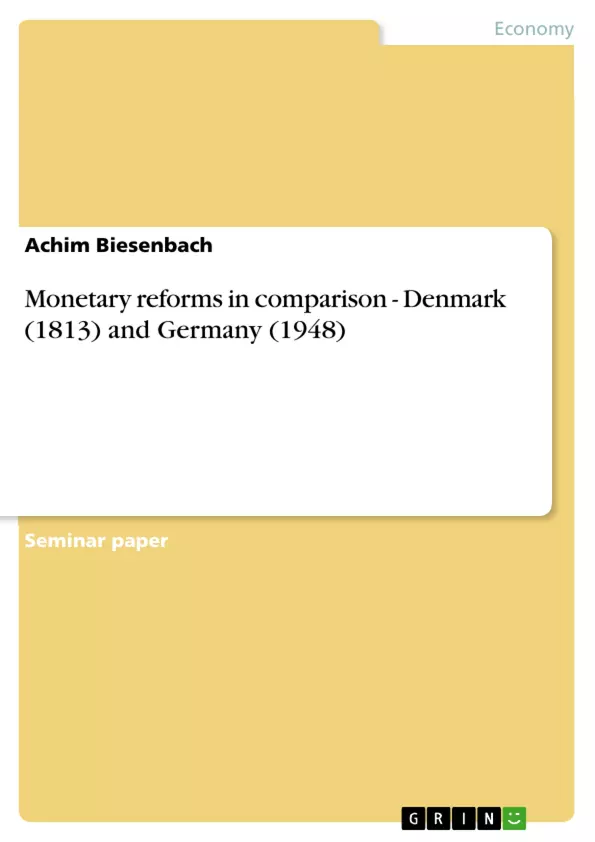In times of open or suppressed inflation when a monetary reform becomes inevitable, economic theory can help to make the right decisions. Monetary concepts like the quantity equation and the theory of monetary reforms would have helped to avoid the mistakes of the Danish reform in 1813. Additionally, they would have confirmed the decision makers of the German reform in 1948 in their actions.
Fortgeschrittene offene oder große zurückgestaute Inflation zieht meist zwangsläufig eine sanierende Währungsreform nach sich. Hierbei kann die Geldtheorie helfen, die richtigen Entscheidungen zu treffen. Konzepte wie die Quantitätsgleichung hätten geholfen, die Fehler der dänischen Währungsreform von 1813 zu vermeiden. Die Theorie hätte die Entscheidungsträger der deutschen Währungsreform von 1948 in ihrem Vorhaben bestärkt.
Inhaltsverzeichnis (Table of Contents)
- INTRODUCTION
- ABOUT THE NECESSITY OF MONETARY REFORMS
- ADVANCED OPEN INFLATION
- GREAT SUPPRESSED INFLATION
- THE REFORM BUNDLE FOR ADVANCED OPEN INFLATION
- THE REFORM BUNDLE FOR GREAT SUPPRESSED INFLATION
- THE MONETARY REFORM IN DENMARK (1813)
- PRE-REFORM STATE
- REFORM'S ENFORCEMENT
- THE MONETARY REFORM IN GERMANY (1948)
- PRE-REFORM STATE
- REFORM'S ENFORCEMENT
- SIMILARITIES AND DIFFERENCES
- TWO REFORMS IN OVERVIEW
- MONEY STOCK ESTIMATION
Zielsetzung und Themenschwerpunkte (Objectives and Key Themes)
This paper compares the monetary reforms in Denmark (1813) and Germany (1948) to derive general recommendations for decision-makers of future monetary reforms. It investigates the necessity of monetary reforms in times of advanced open or great suppressed inflation, analyzing the theoretical framework and practical applications.- Necessity of monetary reforms in cases of advanced open and suppressed inflation
- Analysis of the Danish monetary reform of 1813
- Analysis of the German monetary reform of 1948
- Comparison of both reforms to identify similarities and differences
- Derivation of general recommendations for decision-makers of future monetary reforms
Zusammenfassung der Kapitel (Chapter Summaries)
The introduction provides an overview of the historical context of monetary reforms, emphasizing the role of inflation and government intervention. It introduces the two case studies: the Danish monetary reform of 1813 and the German monetary reform of 1948, highlighting their significance for understanding the broader principles of monetary reform. Chapter 2 delves into the theoretical underpinnings of monetary reforms, focusing on the concept of advanced open and great suppressed inflation. It explains the characteristics, causes, and economic consequences of these inflationary states, highlighting the need for a comprehensive reform approach. This chapter establishes the theoretical framework for analyzing the two case studies. Chapter 3 focuses on the Danish monetary reform of 1813. It explores the pre-reform economic state, the specific measures taken, and the resulting outcomes. It examines the reform's success and failures, offering insights into the challenges and limitations of such reforms. Chapter 4 examines the German monetary reform of 1948. It provides a detailed analysis of the pre-reform economic state, the implementation of the reform, and its economic consequences. It highlights the reform's successes and offers insights into the factors that contributed to its successful implementation. Chapter 5 compares and contrasts the two reforms, highlighting their similarities and differences. This chapter focuses on identifying key lessons learned from both cases and their relevance for future monetary reform initiatives.Schlüsselwörter (Keywords)
Monetary reforms, inflation, advanced open inflation, suppressed inflation, Denmark, Germany, 1813, 1948, economic history, monetary policy, currency reform, quantity equation, theory of monetary reforms.- Arbeit zitieren
- Achim Biesenbach (Autor:in), 2008, Monetary reforms in comparison - Denmark (1813) and Germany (1948), München, GRIN Verlag, https://www.grin.com/document/113633



